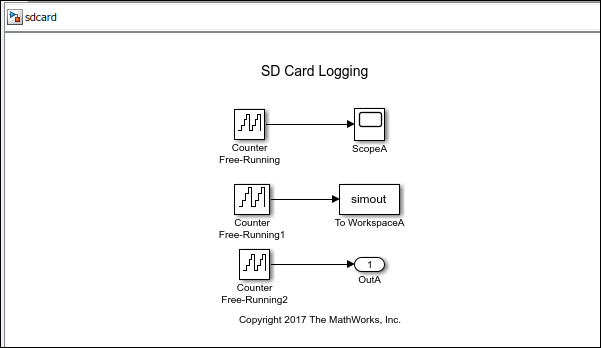Log Signals on a Hardware
You can use MAT-file logging to save signals from Simulink® models on a hardware. The signals from these models are saved
as data points in MAT-files. With the data you log, you can apply fault analysis, search
for transient behavior, or analyze sensor data collected over a long period of time. The
data points can be saved in: Structure, Structure with
time, or Array format. Simulink supports logging signals on the hardware from only these three blocks:

Without MAT-file logging on the hardware, you can only log and analyze data on the hardware through External mode or by sending the signal to a computer (using Serial, UDP, or TCP) and storing it in MATLAB®. These mechanisms need an active connection between a computer and the hardware when logging data. With MAT-file logging, you can log data without any need to connect the hardware to a computer. Other advantages of logging data to SD card over other mechanisms are:
The ability to collect data over a long duration for analysis.
The ability to store the data in a well-structured MAT-file, including timestamp information.
Before you start to save signals from Simulink models on the hardware, complete the steps listed in Prerequisites for Logging Signals.
Configure Board Parameters and Enable MAT-File Logging: To save MAT-files on the hardware, the MAT-file logging option in the Configuration Parameters dialog box must be selected. Also, the hardware parameters must be specified.
Configure Model to Log Signals on the Hardware: MAT-file logging is supported in models containing To Workspace, Scope, or Outport blocks. You must specify the values for several block parameters.
Run Model on the Hardware: Simulink deploys code and logs signals on the hardware as MAT-files.
Import MAT-Files into MATLAB: After logging is complete, you can open MAT-files in MATLAB and use them for further analysis.